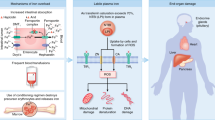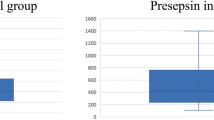Abstract
Although fluoroquinolones or other antibiotics are commonly used to prevent bacterial infections after hematopoietic cell transplantation (HCT), because of the growing presence of multidrug-resistant microorganisms, it is important to identify patients who are more likely to benefit from antibacterial prophylaxis. To evaluate risk factors for early bacterial infection after allogeneic HCT, we retrospectively analyzed clinical data for 112 consecutive adult patients with hematological malignancies who received transplants without any antibacterial prophylaxis. The cumulative incidence of bacterial infection at 30 days after transplantation was 16%. Among various pre-transplant factors, only high serum ferritin (>700 ng/mL, 47 patients) and high C-reactive protein (CRP) (>0.3 mg/dL, 28 patients) levels were significantly associated with the development of bacterial infection in a multivariate analysis (hazard ratio (95% confidence interval): ferritin, 4.00 (1.32–12.17); CRP, 3.64 (1.44–9.20)). In addition, septic shock and sepsis with organ failure were exclusively observed in patients who had high ferritin and/or high CRP levels. These results suggest that pretransplant serum ferritin and CRP levels can be useful markers for predicting the risk of early bacterial infection after allogeneic HCT. It may be prudent to limit antibacterial prophylaxis to patients with predefined risk factors to ensure the safety of HCT with the use of fewer antibiotics.
This is a preview of subscription content, access via your institution
Access options
Subscribe to this journal
Receive 12 print issues and online access
$259.00 per year
only $21.58 per issue
Buy this article
- Purchase on Springer Link
- Instant access to full article PDF
Prices may be subject to local taxes which are calculated during checkout



Similar content being viewed by others
References
Poutsiaka DD, Price LL, Ucuzian A, Chan GW, Miller KB, Snydman DR . Blood stream infection after hematopoietic stem cell transplantation is associated with increased mortality. Bone Marrow Transplant 2007; 40: 63–70.
Gratwohl A, Brand R, Frassoni F, Rocha V, Niederwieser D, Reusser P et al. Cause of death after allogeneic haematopoietic stem cell transplantation (HSCT) in early leukaemias: an EBMT analysis of lethal infectious complications and changes over calendar time. Bone Marrow Transplant 2005; 36: 757–769.
Trifilio S, Verma A, Mehta J . Antimicrobial prophylaxis in hematopoietic stem cell transplant recipients: heterogeneity of current clinical practice. Bone Marrow Transplant 2004; 33: 735–739.
Yoshida M, Ohno R . Current antimicrobial usage for the management of infections in leukemic patients in Japan: results of a survey. Clin Infect Dis 2004; 39 (Suppl 1): S11–S14.
Kruger WH, Hornung RJ, Hertenstein B, Kern WV, Kroger N, Ljungman P et al. Practices of infectious disease prevention and management during hematopoietic stem cell transplantation: a survey from the European group for blood and marrow transplantation. J Hematother Stem Cell Res 2001; 10: 895–903.
Prabhu RM, Piper KE, Litzow MR, Steckelberg JM, Patel R . Emergence of quinolone resistance among viridans group streptococci isolated from the oropharynx of neutropenic peripheral blood stem cell transplant patients receiving quinolone antimicrobial prophylaxis. Eur J Clin Microbiol Infect Dis 2005; 24: 832–838.
Frere P, Hermanne JP, Debouge MH, Fillet G, Beguin Y . Changing pattern of bacterial susceptibility to antibiotics in hematopoietic stem cell transplant recipients. Bone Marrow Transplant 2002; 29: 589–594.
Saito T, Yoshioka S, Iinuma Y, Takakura S, Fujihara N, Ichinohe T et al. Effects on spectrum and susceptibility patterns of isolates causing bloodstream infection by restriction of fluoroquinolone prophylaxis in a hematology-oncology unit. Eur J Clin Microbiol Infect Dis 2008; 27: 209–216.
Gafter-Gvili A, Paul M, Fraser A, Leibovici L . Effect of quinolone prophylaxis in afebrile neutropenic patients on microbial resistance: systematic review and meta-analysis. J Antimicrob Chemother 2007; 59: 5–22.
Kern WV, Klose K, Jellen-Ritter AS, Oethinger M, Bohnert J, Kern P et al. Fluoroquinolone resistance of Escherichia coli at a cancer center: epidemiologic evolution and effects of discontinuing prophylactic fluoroquinolone use in neutropenic patients with leukemia. Eur J Clin Microbiol Infect Dis 2005; 24: 111–118.
Gomez L, Garau J, Estrada C, Marquez M, Dalmau D, Xercavins M et al. Ciprofloxacin prophylaxis in patients with acute leukemia and granulocytopenia in an area with a high prevalence of ciprofloxacin-resistant Escherichia coli. Cancer 2003; 97: 419–424.
Martino R, Subira M, Altes A, Lopez R, Sureda A, Domingo-Albos A et al. Effect of discontinuing prophylaxis with norfloxacin in patients with hematologic malignancies and severe neutropenia. A matched case-control study of the effect on infectious morbidity. Acta Haematol 1998; 99: 206–211.
Cattaneo C, Quaresmini G, Casari S, Capucci MA, Micheletti M, Borlenghi E et al. Recent changes in bacterial epidemiology and the emergence of fluoroquinolone-resistant Escherichia coli among patients with haematological malignancies: results of a prospective study on 823 patients at a single institution. J Antimicrob Chemother 2008; 61: 721–728.
Mikulska M, Del Bono V, Raiola AM, Bruno B, Gualandi F, Occhini D et al. Blood stream infections in allogeneic hematopoietic stem cell transplant recipients: reemergence of Gram-negative rods and increasing antibiotic resistance. Biol Blood Marrow Transplant 2009; 15: 47–53.
Kanda J, Ichinohe T, Saito T, Yamashita K, Kondo T, Ishikawa T et al. Impact of discontinuing fluoroquinolone prophylaxis on early mortality after allogeneic marrow or peripheral blood SCT with myeloablative conditioning. Bone Marrow Transplant (e-pub ahead of print 7 December 2009; doi:10.1038/bmt.2009.344).
Pullarkat V, Blanchard S, Tegtmeier B, Dagis A, Patane K, Ito J et al. Iron overload adversely affects outcome of allogeneic hematopoietic cell transplantation. Bone Marrow Transplant 2008; 42: 799–805.
Sato M, Kako S, Oshima K, Sato K, Terasako K, Kimura S et al. Prediction of infectious events by high-sensitivity C-reactive protein level before undergoing chemotherapy for acute myeloid leukaemia. Scand J Infect Dis 2010; 42: 97–101.
Artz AS, Wickrema A, Dinner S, Godley LA, Kocherginsky M, Odenike O et al. Pretreatment C-reactive protein is a predictor for outcomes after reduced-intensity allogeneic hematopoietic cell transplantation. Biol Blood Marrow Transplant 2008; 14: 1209–1216.
Gooley TA, Leisenring W, Crowley J, Storer BE . Estimation of failure probabilities in the presence of competing risks: new representations of old estimators. Stat Med 1999; 18: 695–706.
Fine J, Gray R . A proportional hazards model for the subdistribution of a competing risk. J Am Stat Assoc 1999; 94: 496–497.
Khan FA, Fisher MA, Khakoo RA . Association of hemochromatosis with infectious diseases: expanding spectrum. Int J Infect Dis 2007; 11: 482–487.
Bullen JJ, Rogers HJ, Spalding PB, Ward CG . Natural resistance, iron and infection: a challenge for clinical medicine. J Med Microbiol 2006; 55: 251–258.
McCord JM . Iron, free radicals, and oxidative injury. Semin Hematol 1998; 35: 5–12.
Sahlstedt L, Ebeling F, von Bonsdorff L, Parkkinen J, Ruutu T . Non-transferrin-bound iron during allogeneic stem cell transplantation. Br J Haematol 2001; 113: 836–838.
Sahlstedt L, von Bonsdorff L, Ebeling F, Parkkinen J, Juvonen E, Ruutu T . Non-transferrin-bound iron in haematological patients during chemotherapy and conditioning for autologous stem cell transplantation. Eur J Haematol 2009; 83: 455–459.
Evens AM, Mehta J, Gordon LI . Rust and corrosion in hematopoietic stem cell transplantation: the problem of iron and oxidative stress. Bone Marrow Transplant 2004; 34: 561–571.
Weinberg ED . Iron availability and infection. Biochim Biophys Acta 2009; 1790: 600–605.
von Bonsdorff L, Sahlstedt L, Ebeling F, Ruutu T, Parkkinen J . Erratum to ‘Apotransferrin administration prevents growth of Staphylococcus epidermidis in serum of stem cell transplant patients by binding of free iron’. (FEMS Immunol. Med Microbiol. 37 (2003) 45-51). FEMS Immunol Med Microbiol 2004; 40: 173–180.
Kataoka K, Nannya Y, Hangaishi A, Imai Y, Chiba S, Takahashi T et al. Influence of pretransplantation serum ferritin on nonrelapse mortality after myeloablative and nonmyeloablative allogeneic hematopoietic stem cell transplantation. Biol Blood Marrow Transplant 2009; 15: 195–204.
Majhail NS, Lazarus HM, Burns LJ . Iron overload in hematopoietic cell transplantation. Bone Marrow Transplant 2008; 41: 997–1003.
Armand P, Kim HT, Cutler CS, Ho VT, Koreth J, Alyea EP et al. Prognostic impact of elevated pretransplantation serum ferritin in patients undergoing myeloablative stem cell transplantation. Blood 2007; 109: 4586–4588.
Raptis A, Duh MS, Wang ST, Dial E, Fanourgiakis I, Fortner B et al. Treatment of transfusional iron overload in patients with myelodysplastic syndrome or severe anemia: data from multicenter clinical practices. Transfusion 2010; 50: 190–199.
Pullarkat V . Objectives of iron chelation therapy in myelodysplastic syndromes: more than meets the eye? Blood 2009; 114: 5251–5255.
Takatoku M, Uchiyama T, Okamoto S, Kanakura Y, Sawada K, Tomonaga M et al. Retrospective nationwide survey of Japanese patients with transfusion-dependent MDS and aplastic anemia highlights the negative impact of iron overload on morbidity/mortality. Eur J Haematol 2007; 78: 487–494.
Lee MH, Means Jr RT . Extremely elevated serum ferritin levels in a university hospital: associated diseases and clinical significance. Am J Med 1995; 98: 566–571.
St Pierre TG, Clark PR, Chua-anusorn W, Fleming AJ, Jeffrey GP, Olynyk JK et al. Noninvasive measurement and imaging of liver iron concentrations using proton magnetic resonance. Blood 2005; 105: 855–861.
Acknowledgements
We are grateful to Rie Goi and Mika Kobayashi for their expert data management and secretarial assistance, and to all of the members of the transplant and infection-control teams at Kyoto University Hospital for their dedicated care of the patients and donors.
Author information
Authors and Affiliations
Corresponding author
Ethics declarations
Competing interests
The authors declare no conflict of interest.
Rights and permissions
About this article
Cite this article
Kanda, J., Mizumoto, C., Ichinohe, T. et al. Pretransplant serum ferritin and C-reactive protein as predictive factors for early bacterial infection after allogeneic hematopoietic cell transplantation. Bone Marrow Transplant 46, 208–216 (2011). https://doi.org/10.1038/bmt.2010.108
Received:
Revised:
Accepted:
Published:
Issue Date:
DOI: https://doi.org/10.1038/bmt.2010.108
Keywords
This article is cited by
-
The relationship between serum ferritin level and clinical outcomes in sepsis based on a large public database
Scientific Reports (2023)
-
High CRP-albumin ratio predicts poor prognosis in transplant ineligible elderly patients with newly diagnosed acute myeloid leukemia
Scientific Reports (2022)
-
Transfusional iron overload and intravenous iron infusions modify the mouse gut microbiota similarly to dietary iron
npj Biofilms and Microbiomes (2019)
-
G-CSF-primed haplo-identical HSCT with intensive immunosuppressive and myelosuppressive treatments does not increase the risk of pre-engraftment bloodstream infection: a multicenter case–control study
European Journal of Clinical Microbiology & Infectious Diseases (2019)
-
Development of a simplified multivariable model to predict neutropenic complications in cancer patients undergoing chemotherapy
Supportive Care in Cancer (2018)



